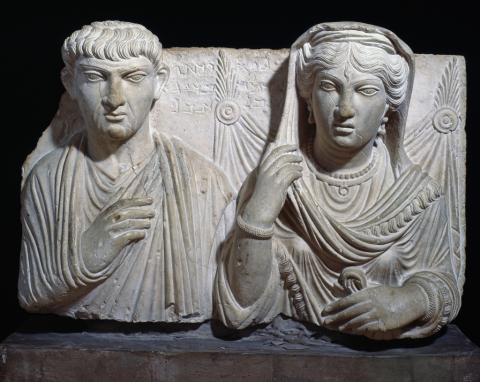Funerary Portrait: Yarkhai Son of Ogga and Balya His Daughter
Funerary Portrait: Yarkhai Son of Ogga and Balya His Daughter
Late Antique (Palmyra), ca. 150-200 CE
limestone
height 53.3 cm
width 81.3 cm
depth 17.8 cm
Inscription in Aramaic
Portland Art Museum European Collection, 54.3
Gift of Mr. Aziz E. Atiyeh
Melissa Medefesser, Medieval Portland seminar student, 2015
Yarkhai, Son of Ogga, and his daughter Balya, is a double portrait Palmyrene funerary bust dating between 150-200 CE. Busts such as this one were carved into limestone and served as decorate covers for niches inside tombs. Aramaic inscriptions above the shoulders indicate the figures by name and relation.
The name Yarkhai is associated with a moon deity. He is depicted in a Greek himation and chiton, which were standard garments in depictions of male figures. Like many Palmyrene funerary busts, the right arm is wrapped in the himation and his hand is placed on his chest. This gesture is likely derived from the philosopher's pose in Greek sculpture.[1]
Balya's name refers to the Palmyrene deity Ba'al.[2] A dorsalium, a draped cloth set in place by two circular pins, is engraved behind Balya indicating that she was the first to die.[3] In contrast to the austere depiction of Yarkhai, Balya is portrayed in more elaborate clothing and adorned with several pieces of jewelry including earrings, necklaces, and bracelets. Her cloak is decorated with fringed edges and is veiled over the top of her head. The length of one side is draped across her chest and tucked over her left shoulder. Her right hand is raised to hold the veil near her shoulder, a commonly portrayed gesture on female Palmyrene busts.
The cloak extends down her torso, loosely clinging over her chest to reveal the shape of her breasts. A looped fold of the cloak is delicately held by her left hand and a small, carved hole emphasizes the slight bend of her wrist above the garment. These characteristics depart from earlier depictions of female figures, which were represented in more austere clothing and often shown holding domestic objects such as spindles and distaffs. This change was likely related to an increase in wealth in Palmyra.[4] Female Palmyrene funerary busts display many variations of headdresses and hairstyles, possibly associating them with certain clans or villages. A folded diadem, possibly textile, rests on the top of Balya's head underneath her veil. Her wavy hair is parted down the center with a single strand placed down the center of her forehead and on the side of each ear.
Yarkhai and Balya are idealized representations, however, they display more naturalistic features than earlier busts. Examples of this are: tear ducts are portrayed on precisely carved almond-shaped eyes, creases of flesh are shown through slight indentations on Yarkhai's forehead and lower cheek as well as Balya's neck, and finally, Balya's lips are slightly parted to reveal a glimpse of her teeth.
Records indicate that this bust was owned by Mr. Hammaoui, in Homs, Syria in 1902. It became part of a private collection in Homs in 1928 and was purchased by Mr. Aziz Atiyeh in 1933. Finally, in 1953, Mr. Atiyeh donated this sculpture, along with two other Palmyrene busts, to the Portland Art Museum.
Notes
[1] Collection Notes, File 54. 1-3, Archives Department, Portland Art Museum.
[2] Ibid.
[3] Francis J. Newton, "Three Tomb Sculptures from Palmyra," Notes on the Collection, no. 5 (1964-65), Portland Art Museum.
[4] Malcolm A.R. Colledge, The Art of Palmyra (Boulder: Westview Press, 1976), 70-71.
[5] Cynthia Finlayson, "Veil, Turban, and Headpiece-Female Status and Funerary Portraiture at Palmyra, Syria," (Ph.D. diss, University of Iowa, 1998): 124.
[6] Newton.
Bibliography
Colledge, Malcolm A.R. The Art of Palmyra. Boulder: Westview Press, 1976.
Finlayson, Cynthia. "Veil, Turban, and Headpiece-Female Status and Funerary Portraiture at Palmyra, Syria." Ph.D. diss., University of Iowa, 1998.
Newton, Francis J. "Three Tomb Sculptures from Palmyra." Notes on the Collection, no. 5 (1964-65). Portland Art Museum.
Portland Art Museum. Palmyrene Sculptures. File 54. 1-3. Archives Department.

